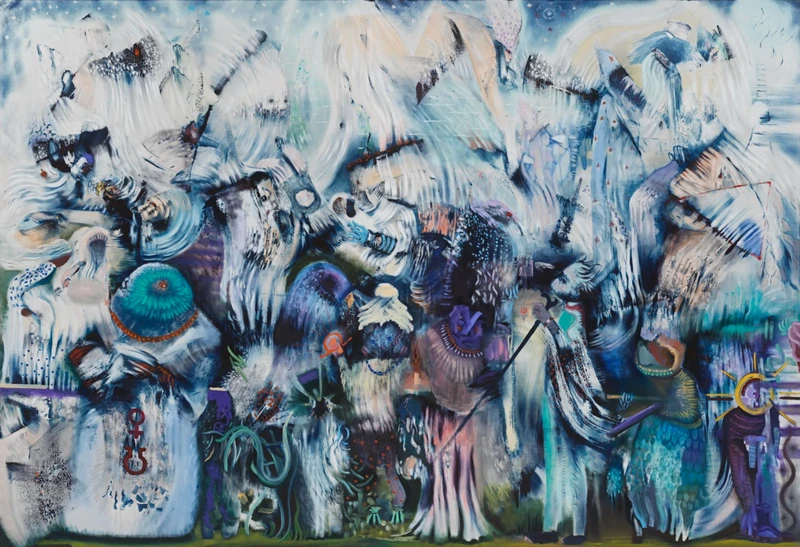Ali Banisadr: The Changing Past
11 Oct-11 Nov 2023


Victoria Miro is delighted to announce The Changing Past, an exhibition of paintings by Ali Banisadr. Opening in October, the first solo presentation of works by the New York-based artist since he joined the gallery in 2021 features a substantial body of paintings completed over the past two years. The exhibition will be accompanied by a catalogue featuring new writing on the artist.
A painter of epic vistas and dazzling intricacies, Ali Banisadr creates complex worlds whose syncopated rhythms corral a multitude of references from history and art history, as well as allusions to our own turbulent times. In any single, expansive canvas one might sense the crystalline detail of the Persian miniature tradition, the muscular brushwork of Abstract Expressionism, the narrative dexterity of the early Dutch masters, the bravura technique of the Venetian Renaissance, or the libidinous glyphs of Surrealism, among others.
Banisadr’s works invite the viewer to move through time, encountering different art histories and different cultures while contemplating contemporary issues through the lens of the past. Works on view will include Queen of the Night, 2022, a large-scale painting inspired by The Burney Relief (also referred to as the Queen of the Night relief), which is on display in the British Museum, London. A Mesopotamian terracotta relief made in the Old-Babylonian period (19th–18th century BCE), it depicts a winged deity, with bird feet and prominent talons, wearing a headdress of horns, elaborate jewellery, holding a rod and ring in each hand. In Mesopotamian art, the rod and ring symbol, like the horned helmet or crown, are indicators of the depicted being’s divine status. This symbol also represents ‘respect’, ‘justice’ and the ‘balance of power’.
This figure stands in the centre of Banisadr’s painting, addressing the viewer. To the left stands a high priestess equally adorned with jewellery, with the symbol for ‘woman’ and ‘life’ on the front of her gown. Also in attendance are other bird-like creatures of divine status. In Mesopotamia, birds were often symbolic of the future. Born in Tehran in 1976, Banisadr has commented on childhood memories of the Islamic revolution and the Iran-Iraq war as being ‘a mix of images, half abstract and half recognisable forms.’ Symbolism relating to present-day events in the country, and how these are received and consumed around the world, lend Queen of the Night an urgency that speaks candidly to the contemporary moment.
Also on view, The Changing Past, 2021, evokes the ways in which, throughout history, monuments, buildings and often entire cultures are toppled or erased in order to accommodate new beliefs and ideas, which in turn are succeeded by further layers of thinking or sets of ideals. Reflective of Banisadr’s ongoing interest in iconoclasm, the motifs in the painting are trans-historical: a disc, for instance, refers to a symbol from Ancient Egyptian times that migrates through time, its meaning and significance changed. Shifting thoughts and philosophies similarly echo through the work. G.I. Gurdjieff, the Russian born, Greco-Armenian philosopher, mystic and spiritual teacher whose work helped to bring ancient teachings and mysticism to the West, is cited as an influence. An enduring source of inspiration is the ancient Mesopotamian poem The Epic of Gilgamesh, which provides the artist with a rich source of visual imagery.
In Banisadr’s art such references reveal themselves not as static, sedimentary layers but as successive waves or currents. His abstract and semi-abstract forms flow together, intermingle or collide, submerging and resurfacing through the process of painting to become recast and transformed. With their legions of strafing lines, arcs, blurs and smears of colour, Banisadr’s paintings equally evoke the fractured and shimmering surfaces of our digital world.
Ali Banisadr’s exhibition is accompanied by a publication featuring an interview with John Yau and new writing on the artist by Doris Von Drathen and Charlotte Mullins.
About the artist:
Born in 1976 in Tehran, Iran, Ali Banisadr lives and works in Brooklyn, NY. Recent solo institutional exhibitions include Ali Banisadr: Beautiful Lies at Museo Bardini and Palazzo Vecchio, both in Florence, Italy (2021); Ali Banisadr/Matrix 185, Wadsworth Atheneum Museum of Art, Hartford, CT, USA (2020), and Ultramarinus – Beyond the Sea, Benaki Museum, Athens, Greece (2020). His work has been included in recent institutional group exhibitions including Daphne without Apollo: Metamorphoses from Richter to Lassnig, The Opelvillen Foundation, Rüsselsheim, Germany, (2022); Epic Iran, V&A, London, UK (2021); A Boundless Drop to a Boundless Ocean, Orlando Museum of Art, Florida, USA (2021); Rebel, Jester, Mystic, Poet: Contemporary Persians, Asia Society, New York, NY, USA (2021).
Work by the artist is included in major institutional collections including: Albright-Knox Art Gallery, Buffalo, NY, USA; Akademie der Bildenden Künste, Vienna, Austria; British Museum, London, UK; Centre Pompidou, Paris, France; Het Noordbrabants Museum, Den Bosch, Netherlands; Hirshhorn Museum and Sculpture Garden, Washington, DC, USA; K11 Art Foundation, Hong Kong; Los Angeles County Museum of Art, Los Angeles, CA, USA; The Metropolitan Museum of Art, New York, USA; Museum of Contemporary Art, Los Angeles, CA, USA; The Museum of Fine Arts, Houston, USA; Museum der Moderne, Salzburg, Austria; Miniature Museum, The Hague, Netherlands; Philadelphia Museum of Art, Philadelphia, PA, USA; Francois Pinault Foundation, Palazzo Grassi, Venice, Italy; Wadsworth Atheneum Museum of Art, Hartford, CT, USA; among others. The first major monograph on the artist was published by Rizzoli in 2021.